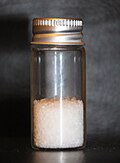Polyvinyl alcohol

| |

| |
| Names | |
|---|---|
| Other names
PVOH; Poly(Ethenol), Ethenol, homopolymer; PVA; Polyviol; Vinol; Alvyl; Alcotex; Covol; Gelvatol; Lemol; Mowiol; Mowiflex, Alcotex, Elvanol, Gelvatol, Lemol, Mowiol, Nelfilcon A, Polyviol und Rhodoviol
| |
| Identifiers | |
| ChEMBL | |
| ChemSpider |
|
| KEGG | |
| RTECS number |
|
| Properties | |
| (C2H4O)x | |
| Density | 1.19-1.31 g/cm3 |
| Melting point | 200 °C (392 °F; 473 K) |
| log P | 0.26 [1] |
Refractive index (nD)
|
1.477 @ 632 nm[2] |
| Hazards | |
| Safety data sheet | External MSDS |
| NFPA 704 (fire diamond) | |
| Flash point | 79.44 °C (174.99 °F; 352.59 K) |
| Lethal dose or concentration (LD, LC): | |
LD50 (median dose)
|
14,700 mg/kg (Mouse) |
Except where otherwise noted, data are given for materials in their standard state (at 25 °C [77 °F], 100 kPa). | |
| Infobox references | |
Poly(vinyl alcohol) (PVOH, PVA, or PVAl) is a water-soluble synthetic polymer. It has the idealized formula [CH2CH(OH)]n. It is used in papermaking, textile warp sizing, as a thickener and emulsion stabilizer in PVAc adhesive formulations and a variety of coatings. It is colourless (white) and odorless. It is commonly supplied as beads or as solutions in water.[3][4]
Uses
PVA is used in a variety of medical applications because of its biocompatibility, low tendency for protein adhesion, and low toxicity. Specific uses include cartilage replacements, contact lenses, and eye drops.[5] Polyvinyl alcohol is used as an aid in suspension polymerizations. Its largest application in China is its use as a protective colloid to make polyvinyl acetate dispersions. In Japan its major use is the production of Vinylon fiber.[6] This fiber is also manufactured in North Korea for self-sufficiency reasons, because no oil is required to produce it. Another application is photographic film.[7]Nowadays PVA-based polymers are being used widely in additive manufacturing. For example, 3D printed oral dosage forms demonstrate great potential in the pharmaceutical industry. It is possible to create drug-loaded tablets with modified drug-release characteristics where PVA is used as a binder substance.[8]
Medically, it may also used as the embolic agent in a Uterine Fibroid Embolectomy (UFE) [9]
Polyvinyl acetals
Polyvinyl acetals are prepared by treating PVA with aldehydes. Butyraldehyde and formaldehyde afford polyvinyl butyral (PVB) and polyvinyl formal (PVF), respectively. Preparation of polyvinyl butyral is the largest use for polyvinyl alcohol in the U.S. and Western Europe.
Medical uses
In terms of medical usage for polyvinyl alcohol one finds that it is used for eye drops (artificial tears), to relieve eye dryness due to a reduced flow of tears.[10][11]
Preparation
Unlike most vinyl polymers, PVA is not prepared by polymerization of the corresponding monomer as the monomer, vinyl alcohol, is thermodynamically unstable with respect to its tautomer acetaldehyde. Instead, PVA is prepared by hydrolysis of polyvinyl acetate,[3] or sometimes other vinyl ester-derived polymers with formate or chloroacetate groups instead of acetate. The conversion of the polyvinyl esters is usually conducted by base-catalysed transesterification with ethanol:
- [CH2CH(OAc)]n + C2H5OH → [CH2CH(OH)]n + C2H5OAc
The properties of the polymer are affected by the degree of transesterification.
Worldwide consumption of polyvinyl alcohol was over one million metric tons in 2006.[6] Large producers include Kuraray (Japan, Europe, and US) and Sekisui Specialty Chemicals (US), while mainland China has installed a number of very large production facilities in the past decade and currently accounts for 45% of world capacity.
Structure and properties
PVA is an atactic material that exhibits crystallinity. In terms of microstructure, it is composed mainly of 1,3-diol linkages [-CH2-CH(OH)-CH2-CH(OH)-] but a few percent of 1,2-diols [-CH2-CH(OH)-CH(OH)-CH2-] occur, depending on the conditions for the polymerization of the vinyl ester precursor.[3]
Polyvinyl alcohol has excellent film forming, emulsifying and adhesive properties. It is also resistant to oil, grease and solvents. It has high tensile strength and flexibility, as well as high oxygen and aroma barrier properties. However, these properties are dependent on humidity: water absorbed at higher humidity levels acts as a plasticiser, which reduces the polymer's tensile strength, but increases its elongation and tear strength.
Safety and environmental considerations
PVA is widely used, thus its toxicity and biodegradation are of interest. Solutions containing up to 5% PVA are nontoxic to fish.[3] It biodegrades slowly.[12]
Society and culture
Cost
the cost of this medication in the U.S. is $6.49 (USD) for 15 ml ophthalmic solution (1.4%)[13][14]
-
Polyvinyl Alcohol costs (US)
-
Polyvinyl Alcohol prescriptions (US)
See also
References
- ↑ "Poly(vinyl alcohol)_msds". Archived from the original on 2021-08-28. Retrieved 2018-12-24.
- ↑ Schnepf MJ, Mayer M, Kuttner C, Tebbe M, Wolf D, Dulle M, et al. (July 2017). "Nanorattles with tailored electric field enhancement". Nanoscale. 9 (27): 9376–9385. doi:10.1039/C7NR02952G. PMID 28656183.
- ↑ 3.0 3.1 3.2 3.3 Hallensleben ML (2000). "Polyvinyl Compounds, Others". Ullmann's Encyclopedia of Industrial Chemistry. Weinheim: Wiley-VCH. doi:10.1002/14356007.a21_743.
- ↑ Tang X, Alavi S (2011). "Recent Advances in Starch, Polyvinyl Alcohol Based Polymer Blends, Nanocomposites and Their Biodegradability". Carbohydrate Polymers. 85: 7–16. doi:10.1016/j.carbpol.2011.01.030.
- ↑ Baker MI, Walsh SP, Schwartz Z, Boyan BD (July 2012). "A review of polyvinyl alcohol and its uses in cartilage and orthopedic applications". Journal of Biomedical Materials Research. Part B, Applied Biomaterials. 100 (5): 1451–7. doi:10.1002/jbm.b.32694. PMID 22514196.
- ↑ 6.0 6.1 SRI Consulting CEH Report Polyvinyl Alcohol Archived 2011-10-14 at the Wayback Machine, published March 2007, abstract retrieved July 30, 2008.
- ↑ Lampman S (2003). Characterization and Failure Analysis of Plastics. ASM International. p. 29.
- ↑ Xu X, Zhao J, Wang M, Wang L, Yang J (August 2019). "3D Printed Polyvinyl Alcohol Tablets with Multiple Release Profiles". Scientific Reports. 9 (1): 12487. doi:10.1038/s41598-019-48921-8. PMC 6713737. PMID 31462744. Archived from the original on 2021-08-28. Retrieved 2020-10-16.
- ↑ Siskin GP (16 November 2018). Cho KJ (ed.). "Uterine Fibroid (Leiomyoma) Embolization and Imaging". WebMD LLC. Archived from the original on 21 February 2020. Retrieved 21 February 2020.
- ↑ "Polyvinyl alcohol for dry eyes. Side effects and dosage". patient.info. Archived from the original on 17 January 2021. Retrieved 12 April 2021.
- ↑ "DailyMed - ARTIFICIAL TEARS- polyvinyl alcohol solution/ drops". dailymed.nlm.nih.gov. Archived from the original on 28 August 2021. Retrieved 12 April 2021.
- ↑ Kawai F, Hu X (August 2009). "Biochemistry of microbial polyvinyl alcohol degradation". Applied Microbiology and Biotechnology. 84 (2): 227–37. doi:10.1007/s00253-009-2113-6. PMID 19590867. S2CID 25068302.
- ↑ "Prescription Price Comparison | Compare Drug Prices". www.wellrx.com. Archived from the original on 28 August 2021. Retrieved 12 April 2021.
- ↑ "WellRx ScriptSave". www.wellrx.com. Archived from the original on 28 August 2021. Retrieved 12 April 2021.
External links
- MSDS Archived 2012-04-15 at the Wayback Machine
- "Slime" recipe
- Forming PVA layers in PET bottles Archived 2005-03-09 at the Wayback Machine
- Pages with script errors
- Webarchive template wayback links
- Chemicals that do not have a ChemSpider ID assigned
- Chemicals without a PubChem CID
- Articles without InChI source
- Articles without UNII source
- Chembox CAS registry number linked
- Articles with changed EBI identifier
- Articles with changed KEGG identifier
- Articles containing unverified chemical infoboxes
- Chembox image size set
- Vinyl polymers
- Biodegradable plastics
- Polymers
- E-number additives


